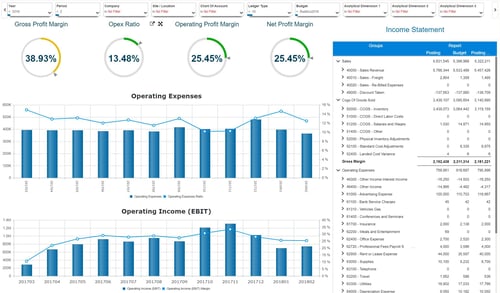Have you ever wondered why your accounts receivable person hates pulling reports? It’s because they don’t have business intelligence tools. Business intelligence software helps staff build accurate reports in less time than ever before. Let’s take a closer look at what business intelligence encompasses, and how organizations are using it to make smart business decisions.
What Is Business Intelligence?
This phrase is thrown around by software developers and business people alike, but it often means different things to different people.
The definition of business intelligence, or BI, is “the delivery of accurate, useful information to the appropriate decision makers within the necessary time frame to support effective decision making.” (Brian Larson, Delivering Business Intelligence with MS SQL Server 2012)
Generally, business intelligence is the aggregation of transactional (sales, inventory or service request) data, which gives decision makers insight into their organization in order to improve business. For example, an outdoor clothing retailer’s sales data might show that while mittens and gloves sell really well in Minnesota and Maine, they don't sell nearly as well in Texas and Florida. Spotting trends like this will help the retailer better understand its customers’ buying behaviors and identify where and how to spend marketing dollars.
Having insights like this allows decision makers to spot trends, identify customer behaviors, predict key events and plan ahead. For instance, BI could show that certain locations in an electrical grid have more problems and power outages during storms. A manager at an electric company can use this information to position repair crews in those locations in the event of an impending storm. This kind of business intelligence can help the electric company minimize outages, and in turn, keep customers satisfied.
Business intelligence is different from the everyday reporting features in your ERP system. It’s a specific software package that can be purchased from your software developer. For Microsoft Dynamics GP users, the business intelligence solution you would want is called Power BI. For Sage users, you might want to consider Sage Enterprise Intelligence. The BI packages are almost always a level above the base-reporting tools that exist in your ERP system.
At the end of the day, business intelligence is all about how we’re able to use smarter data to make better decisions.
What’s In a Good Business Intelligence Solution?
There are a good number of business intelligence solutions out there. The best ones will include the following four areas:
Measurement covers performance metrics and benchmarking.
Analytics cover a wide swath of specific processes including data mining, statistical analysis, and predictive analysis.
Reporting is usually the first functionality implemented in companies. Reporting can be done from the sales level (sales transactions and inventories) or at a higher level that’s pulled from data warehouses so managers, supervisors and owners can get an accurate idea of what’s going on in their business.
Collaboration allows businesses to share information with vendors and or suppliers and let them see which materials are required, and when, during a production run.
How to Use Business Intelligence to Benefit Your Business
Dashboards are key here. You wouldn’t drive a car without a proper dashboard. Your business intelligence dashboard gives you key performance metrics that show you up-to-date information. For a business owner, it gives you an at-a-glance update on how your business is performing. See an example in this video.
There are a lot of business intelligence solutions that allow you to customize your dashboard. Depending on how the business data is stored, a dashboard might show you the total sales for today and compare it with total sales from yesterday, a week ago, and a year ago. It also may indicate if there are problems with sales, such as a sudden increase in returns or cancellations. This allows a business owner to take action when necessary, including adjusting future warehouse orders or working with customer service to understand the issue further.
 |
|
| Accounts Payable Dashboard | Profit/Loss Dashboard |
What Makes Business Intelligence Different Than the Reports I Pull From My ERP Software?
Business intelligence is fueled by data analytics, which makes it work ten times faster than any reporting software we’ve seen. There’s a highly technical process that makes it so speedy.
Here’s how it works:
Analytics is a process of inspecting, cleansing, transforming and modeling data with the goal of discovering useful information, informing conclusions, and supporting decision making (Source: Data Analysis). This is usually done in some sort of data warehouse, separate from a company’s main data stores (sales data, inventory, etc.). This allows for the data to go through a process called ETL (Extract, Transform, and Load). The ETL process is used to remove repeating data, clean out bad or null data, and transform the data into a form that supports faster aggregation by any number of fields. Some of these might include location, time, and product category.
Reporting is usually the most desirable feature of business intelligence for organizations that want better information. Some of these reports may be standardized, such as monthly payroll or sales data. Others may be more specialized by certain fields and date ranges. Reporting software can be purchased separately from a database system or included with the system, such as with Microsoft SQL Server. However, if you’re lucky, some base reporting services can be pre-installed as part of your license agreement.
Data warehouses are usually held separate from the standard production systems, such as Microsoft Dynamics GP or Sage 300, because in a data warehouse, the data is stored differently. The reason for this is so that aggregations by different measures (or dimensions) are faster.
While it is possible, for example, to determine what the sales for a certain product category over a certain time from a certain location is possible in standard production (or transactional) systems, it can put an excessive load on the production system and cause slowdown with any order input. To alleviate this stress, the data warehousing process will extract the appropriate information, rework the structure of the data, and then load it into the warehouse. This extraction process can be run daily, or even on an hourly schedule, depending on how recent the data is required.
The verdict: business intelligence software utilizes a different process that works in conjunction with your ERP software, allowing you to pull accurate reports in seconds. That’s good news for your friends in accounts payable, who no longer have to use valuable hours, or sometimes days, to pull lengthy reports. With business intelligence tools, it can all be done at the click of a button.
Need Help?
Business intelligence doesn’t have to be complicated. If you have questions, or need help building better, faster reports, contact us here or give us a call at 410.685.5512.


